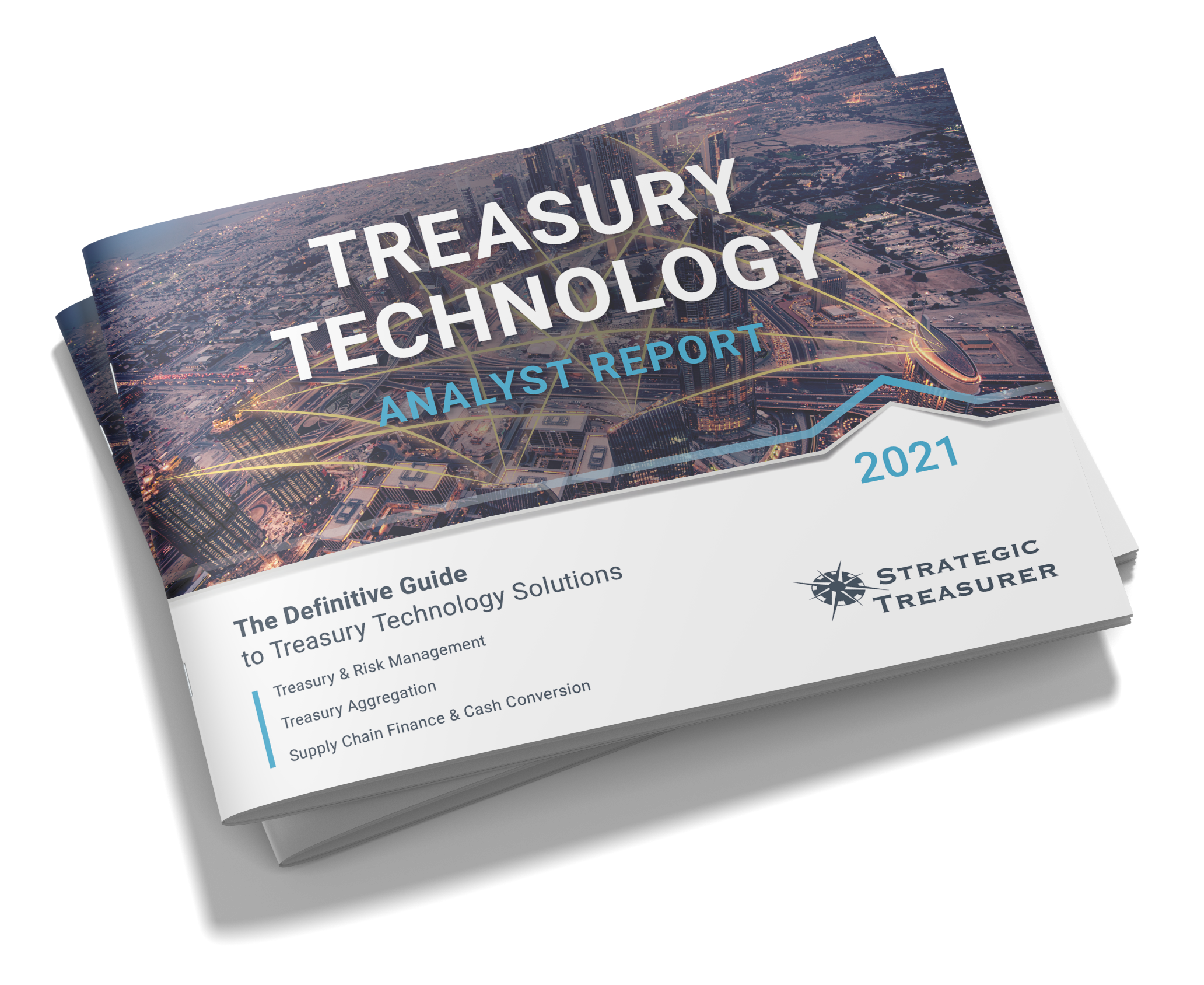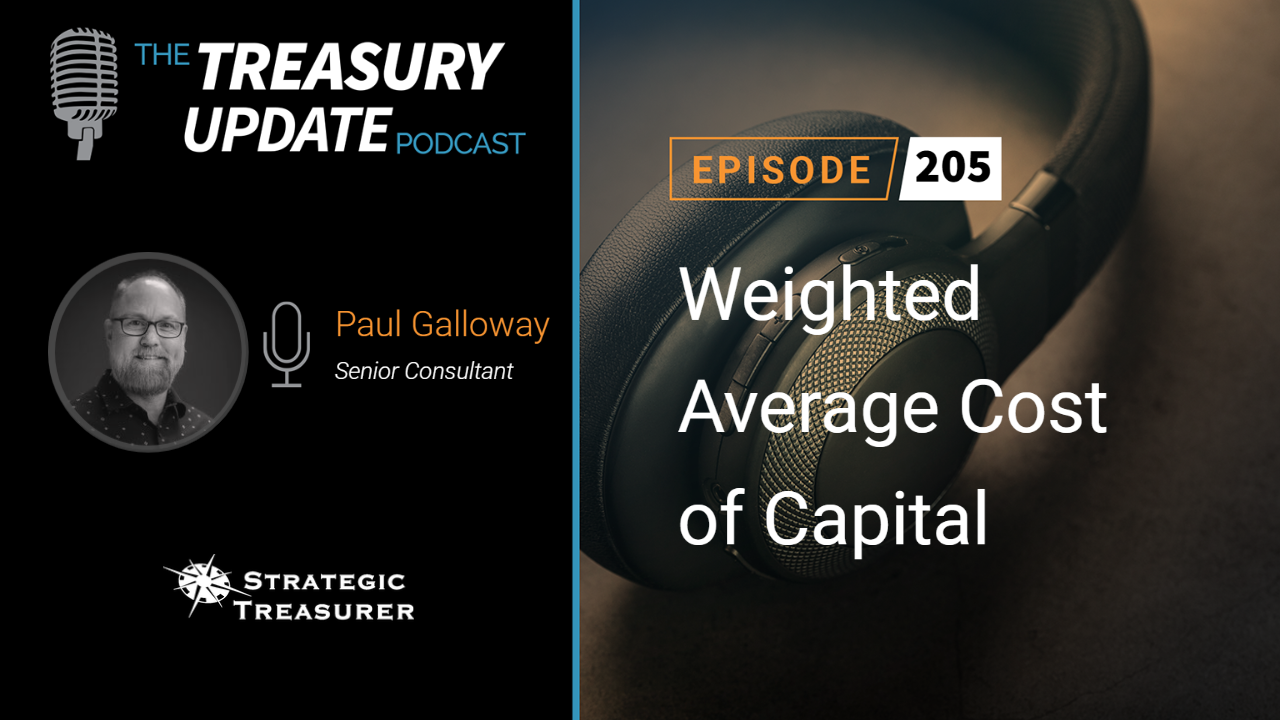
Episode 206
Return of Capital vs. Return on Capital
Building on last week’s podcast on debt and equity, Craig Jeffery and Paul Galloway discuss the differences between the return of capital and the return on capital.
Host:
Craig Jeffery, Strategic Treasurer


Speaker:
Paul Galloway, Strategic Treasurer


Episode Transcription - Episode #206: Return of Capital vs. Return on Capital
Announcer 00:04
Welcome to the Treasury Update Podcast presented by Strategic Treasure, your source for interesting treasury news, analysis, and insights in your car, at the gym, or wherever you decide to tune it.
Craig Jeffery 00:20
Welcome to the Treasury Update Podcast. This is Craig Jeffery. And my guest today is Paul Galloway, who’s also a member of the Senior Advisor Group at Strategic Treasure. Today’s topic is return on capital versus return of capital. Paul, welcome to the Treasury Update Podcast again.
Paul Galloway 00:39
Thanks, Craig. Looking forward to this topic. It’s a it’s an important one important concept for people to understand.
Craig Jeffery 00:48
Since we spoke last time, we talked about the weighted average cost of capital, went through that some are shifting to return on capital, but maybe to begin this conversation in this contrast of return of capital and return on capital, perhaps you could describe the concept or calculation of return on capital. Sure.
Paul Galloway 01:09
Okay, let’s step back a little bit to our discussion around weight of average cost of capital, where we talked about combination of cost of equity and cost of debt. And a lot of companies that are publicly traded today, they have a balance sheet that’s made up of debt and equity. And so when you think about return on capital, it simply is your net income of the company, less any dividends that you pay out, common dividends, divided by total capital, which is combination of equity, and debt.
Craig Jeffery 01:49
Thanks, Paul. So when people look at return on capital, how was I was this calculation used? Who uses it? Why is it important? I guess the other aspect of you know if it’s important sometimes, of course, when is it most important?
Paul Galloway 02:06
Most people probably hear a lot of people talk about return on equity, which is a common financial metric that’s used on the street or markets or by investors. But when you want to look at what the total return that’s being generated by an organization, where you got to look at what are all the cost components to generate that return. So what a return on capital does is it incorporates all that. So it takes into consideration all the revenue that you generate less all your expenses, less your dividends, and it takes it in relation component to your equity, which equity in the arena of a publicly traded company is common stock debt, which is another way for an organization to get capital into the company or funded. And it’s typically at a cheaper cost. Return on capital gives both the equity investor or stock investor and the bond investor visibility to what return is being generated by an organization. So that return is generated by several different ways. It can be investment in products and services that they deliver. It can be investment in mergers, acquisitions, it can be creation of new companies within the organization, or it can be investment in systems of technologies and people to generate more revenue.
Craig Jeffery 03:42
Sure, so let’s shift from return on capital to return of capital.
Paul Galloway 03:48
Yeah, absolutely. So these two components are really important, and they’re intertwined. The reason I say that is, organizations have a limit to what they can get for return on their capital, meaning they’re going to deploy it to the extent that they can get an adequate return to pay back investors, or compensate investors plus some, when they make investments, they’re looking at what the cost of the investment is, the capital associated with making the investment and the return that they’ll get. And so they’ll deploy capital into these various things I talked about earlier. Once they’ve gotten to the point that they can’t generate a return adequate enough to compensate the investors for the required return they have, the next best thing to do is return the capital back to the investors. So return on capital first. Once you’ve deployed all that to the maximum that you can, you can’t generate any more Alpha return or return above that require capital, then you need to return earn it back to the investors. And there’s a couple of ways you can do that. Traditionally, for publicly traded companies, common dividends are the most used way, or common practice for delivering capital back to investors. They can also do extra ordinary dividends. So these would be dividends that aren’t normally accrued for are accounted for in the markets. And generally, companies are given guidance to the street about what their dividend yield will be, or their dividend payments will be, they’ll have a dividend policy in place. Another good way for organizations to return capital back to investors is through share repurchases. And what’s interesting about share repurchases is think about a company, let’s just say company’s worth $5 billion. And they have 1 billion shares outstanding, I’m just making up numbers, and they go out the market and they deploy $500 million to buy back shares, nothing has fundamentally changed for the organization, it’s technically, all things being equal is still worth $5 billion. Now what they’ve done is they’ve taken shares out of the market. So publicly traded company now has less than a billion shares out there, let’s say it’s 900 million shares, if you have 5 billion divided by 1 billion, and compare that to 5 billion divided by 900 million, your share price goes up. Investors like that they want to get appreciation on their stock price, if they can get that, that’s a good thing. That means they have more value in the stock that they hold than what they had before per share. Now the total value of the company hasn’t changed, though.
Craig Jeffery 06:54
In that situation, that’s the idea of the math would work if that’s the case. Now, if you took out $500 million, and you sent it back, you’ve in one sense, you’ve reduced the value of the firm, because now it’s $500 million lighter, the price per share should should decline, at least initially.
Paul Galloway 07:13
One would think that would typically be what you would have happen. What traditionally happens, though, is that over the period of time post the acquisition of the shares, the share price actually will go up over the period of time. And so you can buy back shares in a couple of different ways. So there’s some rules around what you can and can’t do. Because you don’t want to be an influencer of your own share price. When you do share buybacks, you traditionally do that over an extended period of time, and you’re buying a small pocket of shares back every day up to a certain parameter that you’re allowed to. And so technically, if you if you’re deploying capital by returning to investors, yes, you have less capital within the organization, and you would think that your share price will go down. So you can see that your share price might might move a little bit, but over that period with the amounts that you’re doing, you really shouldn’t see a downtick in your share price, your share price should technically go up over the period of the share buyback program,
Craig Jeffery 08:25
I guess I would think that instantly, it should the share price should stay the same. All things being equal, the lack of or the reduction of cash, which gives you flexibility could make it worth slightly less, because the power of flexibility and cash, there’s some value there. But the fact that you’ve gotten rid of an asset that’s not giving you as much return as the rest of the business means that it’s going to be better over time. I think that’s what you were saying with the time element to that.
Paul Galloway 08:57
Exactly, exactly. Some other factors associated with that, Craig, would be if an organization issued more debt, meaning they raised more debt to fund something, and sometimes organizations will raise debt capital, which is cheap, and pay off high cost equity by doing share buybacks with that. So it’s a layer of leveraged share repurchase program that can give you a little extra juice in your share price. Now, assuming that your capital structures still flush enough that you have dry powder for the future, meaning that if you need to access the debt markets to fund something, that you have the ability to do so.
Craig Jeffery 09:43
Paul, you know, the term return of capital, I believe has several uses. And you can tell me, which is the primary use or secondary use but I wanted to give an example. Other people refer to return and capital I believe, is just getting cash back in the same way that you’re saying, but maybe not through share repurchases. I don’t know, if people I don’t know, if you ever watch Shark Tank, Kevin, who’s known as Mr. Wonderful, he usually sits in the middle. And they’re evaluating all these companies, if they’re going to invest in them, he very quickly wants to get into licensing deals where he gets a certain return for every item sold. And he’ll give money for it and you know, he’ll get a certain percentage, then he’s got something that plays after that. So in one sense, he seeks a return of the capital he put in, and then this ongoing residual item, is that more of an informal return of capital? Just the concept? Or how would you, how would you define what Kevin’s doing on Shark Tank with that particular strategy?
Paul Galloway 10:49
It is, what would be considered maybe a more informal return of capital. The other thing that Kevin’s doing there, so Kevin is thinking about both sides of the equation that we’re discussing today, he’s looking at what kind of return on capital can I get, and secondly, when can I get my capital back. And if I get it back quicker, and I’m still able to generate return on the capital that I invested, I’ve reduced my risk. And so Shark Tank, the investors are making high risk investments. And they’re always trying to figure out ways to protect themselves from the downside, because there’s a high probability that some of these investments are going to fail. And they do fail if some of them are quite successful for part of the what Mr. Wonderful is doing, which I really like him a lot in his thought process when he approaches these investments, he’s trying to, he’s trying to get both sides of the equation. And it is an informal return of capital. And when you’re dealing with high risk investments, such as Shark Tank, there’s really no other way to ensure that you’re going to get capital returned to you other than doing some type of licensing deal, or some kind of structure where they meet milestones, they return capital back to you, and you get some kind of return associated, as they’re deploying that service or the product that generates revenue.
Craig Jeffery 12:27
He either has to wait until there’s some kind of sale of the business or some transaction, or this allows him to diversify the flows and the return to get some sooner so that makes sense. Yeah, that makes a lot of sense. You know, when we think about these two scenarios, you know, so how are they compared and contrasted? And I think you’ve described that already from the front end and the back end side, how are they similar? How are they different? Is there anything else about differences or similarities that you’d want to tease out in this discussion?
Paul Galloway 13:02
So obviously, I mean, the, the key components of this are return and capital. Return on and return of capital can be different for every organization and how they deploy it. I think the important takeaway with this is that they are interrelated. And that organizations really need to make sure they have a focus on these two key concepts. Managing this in an efficient way, can really help drive a lot of value to an organization, because people, people will recognize the effort that you’re putting into play and understand better what the value proposition is for the investments made, whether you’re an equity investor, or a debt investor, within the organization. So I think these are really key components, optimizing how you manage it, and manage it, I think is really important. So hopefully, organizations are keeping an eye on these two metrics.
Craig Jeffery 14:12
Yeah, I guess I guess the other thing, Paul is, you know, is there any other guidance? Either looking at these two, I think you’ve explained really well, but we’ve only talked about weighted average cost of capital on this podcast, but other things like internal rate of return, return on investment, et cetera, anything else? Any other models that we should be talking about in future episodes?
Paul Galloway 14:38
Yeah, you hit on something that I think is really important. So internal rate of return or hurdle rate or any other kind of return on invested capital or return on equity components, organizations need to make sure that they understand one, the risks associated with the types of investments they make. And what the minimum required return is the so required to return is what I would equate to a hurdle rate. And a hurdle rate just really says, Hey, Company ABC, you make an investment in what, whether it’s a product or service, or an m&a transaction or something else that would generate some type of cash flows into the future, and has some kind of value either in perpetuity or finite cash flow period, you should be able to determine what the expected return would be on that and compare that to what I would call a benchmark rate, which is your hurdle rate or required return on capital. So these are important concepts that I think are kind of a stepping stone to what we’ve already talked about, weighted average cost of capital, return on, return of capital. So then I think we can take another step and talk about, okay, how to companies view return? And how should they? And what’s the difference between internal rate of return versus net present value? Can they give you different answers? Do they give you good direction? Are they accurate? I think these things are important concepts that organizations need to have people in place that understand them, are able to communicate and educate to senior management team and be able to complete analyses that drive value for organization so that they can make good investment decisions.
Craig Jeffery 16:54
Yeah, this sounds this sounds good. Paul, look forward to some more discussions, you know, as we talk about the, you know, the equity and debt side of the balance sheet, and then we also have discussions about the debt and capital markets. Just you know, whether you’re securing loans or securing investors, the stewardship function of providing for liquidity, providing for the proper return and waiting these things out is, there’s there’s just so much more to talk about. Paul, thanks so much for your time. I look forward to having you on another episode of the Treasury Update Podcast sometime soon.
Paul Galloway 17:29
Thanks, Craig.
Announcer 17:33
You’ve reached the end of another episode of the Treasury Update Podcast. Be sure to follow Strategic Treasure on LinkedIn. Just search for Strategic Treasure. This podcast is provided for informational purposes only, and statements made by Strategic Treasure LLC on this podcast are not intended as legal, business, consulting, or tax advice. For more information, visit and bookmark StrategicTreasurer.com
Subscribe to the Treasury Update Podcast on your favorite app!
Related Resources
Researching new treasury and finance technology can be overwhelming. Strategic Treasurer has stepped in to help. Explore our definitive guide to the treasury technology landscape and discover detailed, data-based coverage of each area.
Weighted Average Cost of Capital
A firm’s debt and equity are important components when investors are watching. What is the cost to fund your operations? What costs are required to make investments or develop new products? In this podcast, Craig Jeffery and Paul Galloway of Strategic Treasurer discuss your WACC or Weighted Average Cost of Capital.








